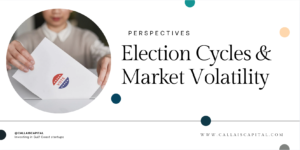
Election Cycles and Market Volatility: What History Tells Us About 2024
Contributions: Justin Callais, Hal Callais
With the recent election of Trump, along with the Federal Open Market Committee (FOMC) meetings, it is easy to get confused as to what the markets are telling us. Luckily, history can tell us something.
Interest rates are determined by both the supply of loanable funds and the demand for such funds. In practice, it means that Federal Reserve activity does not solely lead to changing interest rates. The Federal Reserve can control the supply of loanable funds in the market quite well (though not perfectly), but the demand for such funds is determined by the broader market. To make matters more confusing, movements in short-terms rates and long-run rates occur for different reasons.
Consider the case of January 2001. The Federal Reserve decrease their federal funds rate target from 6.5% to 6%. Stock markets soared, and long-term interest rate yields rose. The stock market increasing post-rate cuts are not abnormal, but long-term rates rising on the announcement of a cut is intriguing. The short-run and long-run bond yields moved in the opposite direction. The fall in short-term rates is expected, as this explains the liquidity effect of expansionary monetary policy. However, there’s also the income effect of monetary policy. This cut influenced yields on the ten-year inflation-indexed notes (the best estimate for real/inflation-adjusted interest rates out there) because of the expectations of future economic growth. The demand for loanable funds will rise as people and businesses are more optimistic about the future, raising interest rates.
In this case, the longer-run income effect dominated the liquidity effect, making long-term rates rise in response.
In 2007, the results were the exact opposite. The Federal Reserve cut interest rates 25 basis points on December 11, 2007, but the Dow Jones dropped 1.5% in response. Long-term interest rate yields fell below short run yields (which is as good of a recession predictor as any). In this scenario, long-term yields fell because of expected decrease in the demand for loanable funds, as those in the market were gearing up for a “Great” Recession. The general lesson going forward is simply: “easy” money boost stocks only to the extent that it leads to expectations of faster economic growth
Now, back to this election’s events. Once it was predicted that Trump was going to win the election, yields on bonds rose. This obviously was not due to Federal Reserve activity, since they FOMC met after the election results came in. This was likely due to (in part) an expected increase in demand for loanable funds.
With the report of the Federal Reserve targeting a 25-basis point cut, we’ve seen some upward movement in stock market activity as a result. In reality, this is likely a lower bound on the true effect, since the expectation was already that the Federal reserve was going to act as they did. The market response suggests that there’s an anticipation that this cut will correspond to an income effect (higher economic growth).
Market expectations suggest that there will likely be another cut at the next FOMC meeting in December. We shall see! But here are a few other ways that this election has impacted the markets.
Capital Markets
Anyone in capital markets has heard this one at least once or twice: “We are waiting for the election results before we consider making new investments.” This year, however, it feels more pronounced and significant. But how does it really stack up to prior election cycles?
Market Measures of Volatility
Analyzing historical data on the CBOE Volatility Index (VIX), we found that the average VIX during election cycles from 1992 to 2024 is 20.84 (excluding the period from August 1 through Election Day each year). In contrast, during non-election years, the VIX averages 19.40 (without election cycle data). This indicates a slightly higher level of volatility during election cycles compared to non-election cycles.
The Great Recession
During the 2008 election cycle, the VIX surged within a 61.25-point range, with an average of 38.48—significantly above the 20.84 average seen in election cycles from 1992 to 2024. Leading up to the 2008 election, the VIX averaged 26.27 before dropping to an average of 15.46 in the period afterward.
These numbers reflect a straightforward story around the financial crisis and subsequent quantitative easing and other accommodative monetary policies by the Fed, which pushed investors into riskier assets during an economic crisis. All of this explains the heightened volatility.
Trump, Pandemic, and Global Events
The pandemic wreaked havoc on the economy, driving volatility up but still not to the levels observed during the Great Recession. Before the 2016 election cycle, the VIX averaged 15.46; it then dipped to 14.23 during the cycle and rose to 17.08 in the period afterward. This indicates that the higher VIX average was primarily driven by lingering effects from the Great Recession, with no substantial election-related volatility in 2016.
During the 2020 election cycle, the VIX remained elevated, averaging 26.99, largely due to the economic impacts of the pandemic and other global events.
2024 Election
Based on our findings, we believe the 2024 election cycle is shaping up to be less volatile than 2020. The VIX currently averages 18.86 for the 2024 election cycle through November 3, down from a pre-election period average of 19.74, even with residual impacts from the pandemic.